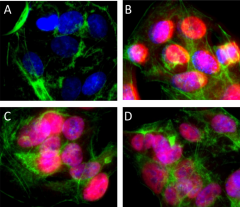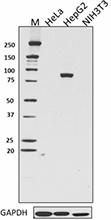- Clone
- W16098A (See other available formats)
- Regulatory Status
- RUO
- Other Names
- Prospero homeobox protein 1, Homeobox prospero-like protein PROX1,
- Isotype
- Rat IgG2a, κ
- Ave. Rating
- Submit a Review
- Product Citations
- publications

-

HepG2 cells were fixed with 4% paraformaldehyde (PFA) for 10 minutes, permeabilized with 0.5% Triton X-100 for 3 minutes, and blocked with 5% FBS for 60 minutes. Then the cells were intracellularly stained overnight at 4°C with (A) 1: 100 diluted (5 µg/ml) Alexa Fluor® 594 rat IgG2a (Cat. No. 400555) or with Alexa Fluor® 594 anti-Prox1 antibody (red) at 1: 100 (5 µg/ml, Figure B), 1: 250 (2 µg/ml, Figure C) and 1: 1000 (0.5 µg/ml, Figure D) dilution. Nuclei were counterstained with DAPI (blue). Actin filaments were labeled with Flash Phalloidin™ Green 488 (green, Cat. No. 424201). The image was captured with a 60X objective.
| Cat # | Size | Price | Save |
|---|---|---|---|
| 696903 | 25 µg | ¥34,980 | |
| 696904 | 100 µg | ¥81,400 |
Prospero homeobox protein 1 (PROX1) is a homeobox transcription factor responsible for progenitor cell differentiation and the development of several organs, such as the central nervous system, lymphatics, pancreas, heart, lens, skeletal muscle, and liver. Prox1-deficient mice lack lymphatic systems and die at day 14.5 of embryogenesis due to multiple developmental defects. In addition to its role in physiological development, PROX1 is involved in carcinogenesis and can act either as a tumor suppressor or as an oncogene depending on the tissue and its expression level. Prox1 is also implicated in the regulation of metabolism in the liver by regulating activities of nuclear receptors including hepatocyte nuclear factor 4a (HNF4a) and liver receptor homolog-1 (LRH-1).
Product DetailsProduct Details
- Verified Reactivity
- Human
- Antibody Type
- Monoclonal
- Host Species
- Rat
- Immunogen
- Human Prox1 recombinant protein (2-259 a.a.) expressed in E. coli.
- Formulation
- Phosphate-buffered solution, pH 7.2, containing 0.09% sodium azide.
- Preparation
- The antibody was purified by affinity chromatography and conjugated with Alexa Fluor® 594 under optimal conditions.
- Concentration
- 0.5 mg/ml
- Storage & Handling
- The antibody solution should be stored undiluted between 2°C and 8°C, and protected from prolonged exposure to light. Do not freeze.
- Application
-
ICC - Quality tested
- Recommended Usage
-
Each lot of this antibody is quality control tested by immunocytochemistry. For immunocytochemistry, a concentration range of 0.5 - 5.0 μg/ml (1:100-1:1000 dilution) is recommended. It is recommended that the reagent be titrated for optimal performance for each application.
* Alexa Fluor® 594 has an excitation maximum of 590 nm, and a maximum emission of 617 nm.
Alexa Fluor® and Pacific Blue™ are trademarks of Life Technologies Corporation.
View full statement regarding label licenses - Application Notes
-
This clone does not cross react with mouse (in-house tested).
- RRID
-
AB_2734537 (BioLegend Cat. No. 696903)
AB_2734537 (BioLegend Cat. No. 696904)
Antigen Details
- Structure
- 737 amino acids with a predicted molecular weight of 83 kD. Contains a C-terminal Prospero-type homeo domain responsible for DNA binding.
- Distribution
-
Nucleus.
- Function
- PROX-1 is a homeobox transcription factor involved in the embryonic development and carcinogenesis.
- Interaction
- Interacts with RORA, RORC, and HNF4a.
- Biology Area
- Cell Biology, Neuroscience, Neuroscience Cell Markers, Transcription Factors
- Molecular Family
- Nuclear Markers
- Antigen References
-
1. Kivelä R, et al. 2016. Nat. Commun. 7:13124.
2. Stergiopoulos A, et al. 2015. Front Cell Neurosci. 8:454.
3. Ragusa S, et al. 2014. Cell Rep. 8:1957.
4. Elsir T, et al. 2012. Cancer Metastasis Rev. 31:793.
5. Karalay O, et al. 2011. Proc. Natl. Acad. Sci. USA. 108:5807.
6. Johnson NC, et al. 2008. Genes Dev. 22:3282. - Gene ID
- 5629 View all products for this Gene ID
- UniProt
- View information about Prox1 on UniProt.org
Related Pages & Pathways
Pages
Related FAQs
Other Formats
View All Prox1 Reagents Request Custom Conjugation| Description | Clone | Applications |
|---|---|---|
| Purified anti-Prox1 | W16098A | WB,ICC |
| Alexa Fluor® 594 anti-Prox1 | W16098A | ICC |
Compare Data Across All Formats
This data display is provided for general comparisons between formats.
Your actual data may vary due to variations in samples, target cells, instruments and their settings, staining conditions, and other factors.
If you need assistance with selecting the best format contact our expert technical support team.
-
Purified anti-Prox1

Total cell lysates (15 µg protein) from HeLa (negative contr... 
HepG2 cells were fixed with 4% paraformaldehyde (PFA) for 1... -
Alexa Fluor® 594 anti-Prox1

HepG2 cells were fixed with 4% paraformaldehyde (PFA) for 10...













Follow Us